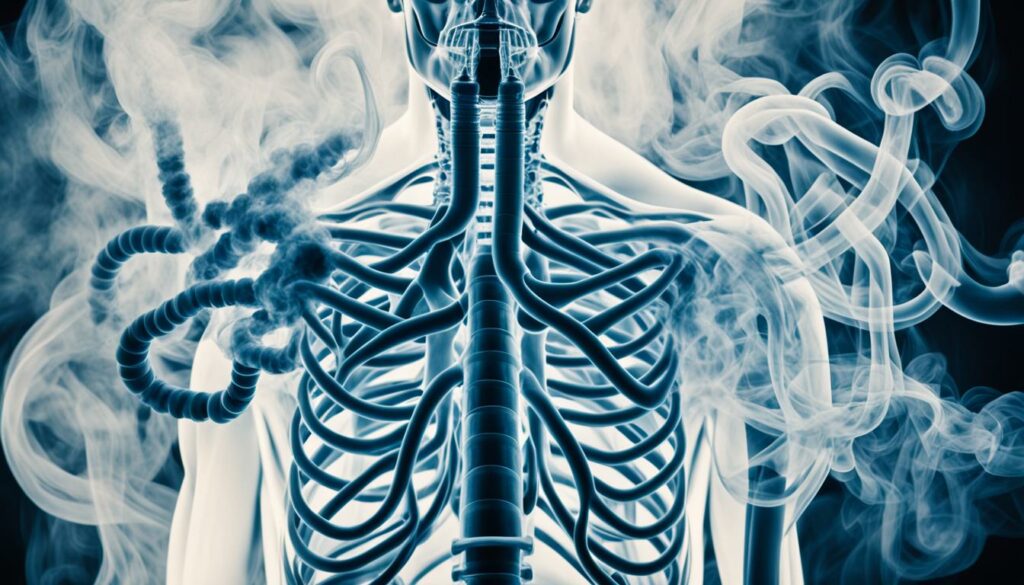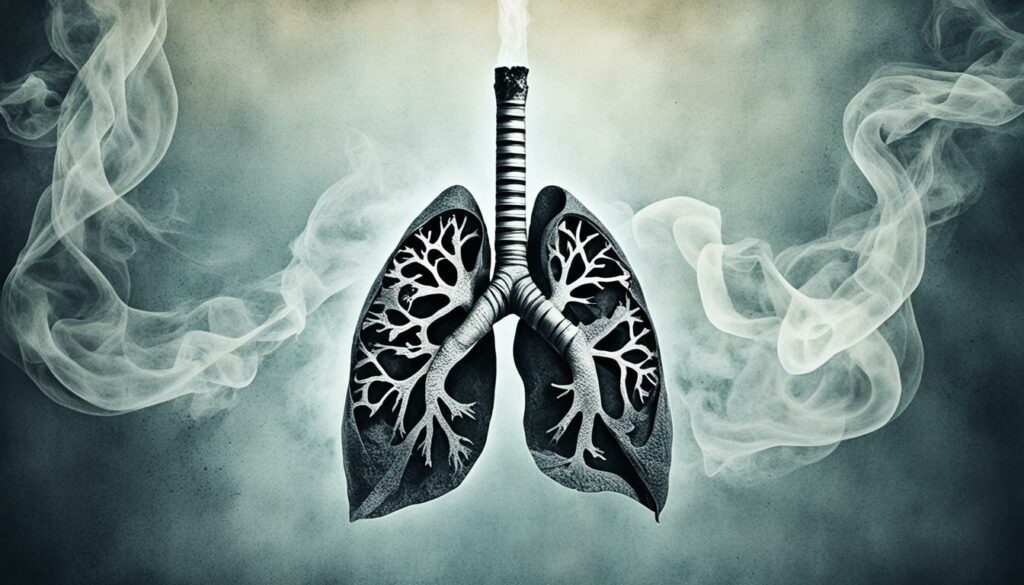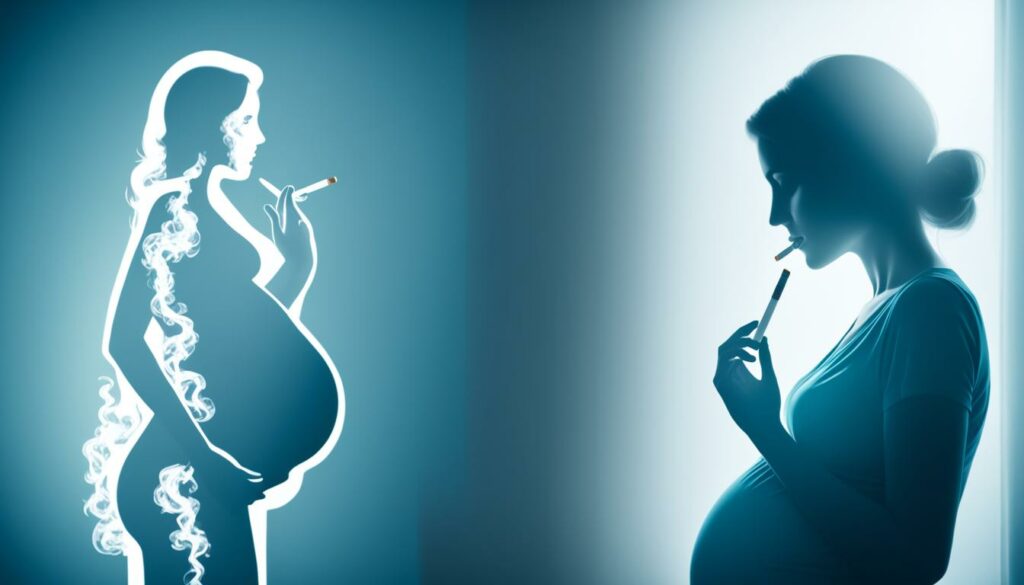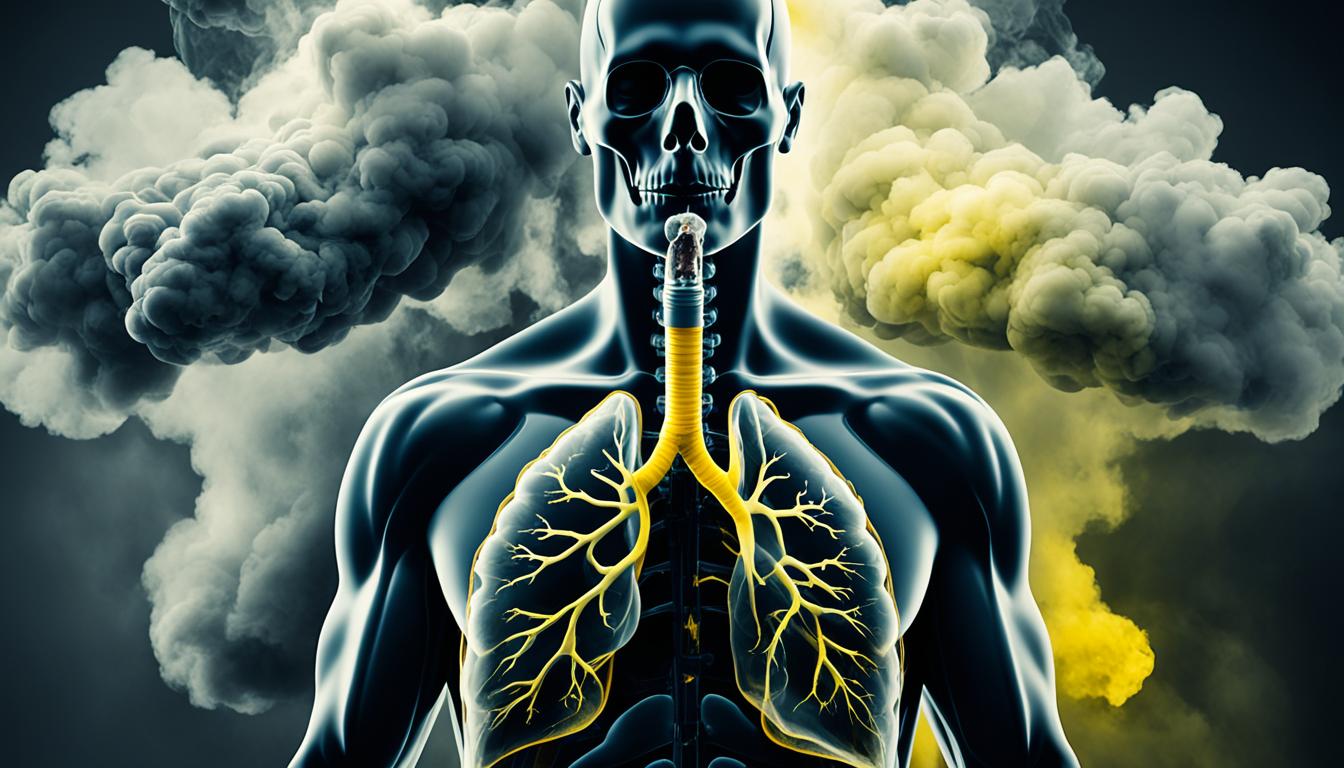Understanding the Risks of a Smoke Habit
Smoking is a widespread habit that poses significant health risks to individuals. From the perspective of public health, it remains a major concern due to the alarming statistics associated with its use and the detrimental effects it has on both smokers and those exposed to secondhand smoke. It is estimated that around 16 million Americans live with smoking-related diseases, and every year, approximately 480,000 people in the United States die due to smoking-related illnesses.
Tobacco, the primary component of cigarettes, introduces more than 5,000 chemicals into the body. Among these chemicals are harmful substances such as carcinogens, which significantly contribute to the development of various diseases. Smoking can cause detrimental effects on almost every organ in the body, including the lungs, heart, and reproductive system.
- Smoking is a major public health concern, with millions of Americans suffering from smoking-related diseases.
- Tobacco smoke contains thousands of chemicals, including carcinogens, which increase the risk of developing various illnesses.
- Smoking affects multiple organs in the body, leading to respiratory issues, heart disease, and reproductive health problems.
- Quitting smoking is the most effective way to reduce these risks and improve overall health.
- Consulting healthcare professionals and utilizing support resources can greatly aid in the process of quitting smoking.
The Chemical Composition of Tobacco Smoke: Understanding the Toxins

Tobacco smoke is comprised of thousands of harmful substances, each having its own detrimental effects on human health. These substances include ammonia, arsenic, formaldehyde, and acetone, among many others.
Moreover, tobacco smoke contains approximately 70 known carcinogens, which are substances capable of causing cancer in living tissue. These carcinogens, such as benzene, polycyclic aromatic hydrocarbons (PAHs), and nitrosamines, pose a significant risk to smokers and those exposed to secondhand smoke.
The primary addictive component in tobacco smoke is nicotine. This addictive substance quickly enters the bloodstream and readily crosses the blood-brain barrier, leading to nicotine addiction. Once addicted, individuals face numerous challenges in quitting smoking and overcoming the stronghold of nicotine.
Understanding the toxic chemicals present in tobacco smoke is essential in realizing the severity of its health implications and the importance of quitting smoking. By comprehending the harmful substances and carcinogens found in tobacco smoke, individuals can make informed decisions that prioritize their well-being and strive to create a smoke-free environment.
“The toxins present in tobacco smoke are a ticking time bomb, silently wreaking havoc on our bodies. Quitting smoking is the most effective way to defuse this bomb and reclaim our health.”
The Chemical Composition of Tobacco Smoke
| Substance | Harmful Effects |
|---|---|
| Ammonia | Irritates the respiratory system, causing coughing and wheezing. |
| Arsenic | |
| Formaldehyde | |
| Acetone | |
| Benzene | Known to cause leukemia and other blood-related cancers. |
| Polycyclic Aromatic Hydrocarbons (PAHs) | |
| Nitrosamines | |
| Nicotine | Addictive substance that increases heart rate, blood pressure, and leads to dependence. |
By visualizing the toxic substances found in tobacco smoke and understanding their harmful effects, individuals are empowered to take the necessary steps towards quitting smoking and protecting their health.
Remember, quitting smoking is a life-changing decision that can greatly improve your well-being and reduce your risk of developing smoking-related diseases. Don’t let tobacco smoke and its harmful constituents hold you back from living a healthier, smoke-free life.
Respiratory Risks: Impact on Lungs and Airway Health

When it comes to the health risks of smoking, the respiratory system is particularly affected. Smoking compromises the supply of oxygen to all organs, as it constricts the airways and increases airway resistance. This can lead to several respiratory complications, including bronchitis, asthma, and emphysema.
The Impact of Smoking on Bronchitis
Bronchitis is a condition characterized by inflammation of the bronchial tubes, which are responsible for carrying air to and from the lungs. Smoking irritates and inflames these tubes, resulting in persistent coughing and difficulty breathing. The constant exposure to harmful substances in tobacco smoke increases the risk of developing bronchitis.
Smoking and the Exacerbation of Asthma
Asthma, a chronic respiratory condition, is often worsened by smoking. The chemicals in tobacco smoke can trigger asthma attacks, leading to wheezing, chest tightness, and shortness of breath. Individuals with asthma who smoke are more likely to experience recurring episodes and have difficulty managing their symptoms.
The Connection Between Smoking and Emphysema
Emphysema is a progressive lung disease that damages the air sacs in the lungs. Smoking is the primary cause of emphysema, as the harmful chemicals found in tobacco smoke destroy these delicate structures. As a result, the lungs lose their ability to exchange oxygen and carbon dioxide effectively.
These respiratory risks associated with smoking highlight the importance of quitting for the sake of lung and airway health. By quitting smoking, individuals can reduce the likelihood of developing bronchitis, experiencing asthma exacerbations, and developing emphysema.
| Respiratory Risks | Associated Conditions |
|---|---|
| Lung Cancer | Increased risk with long-term smoking |
| Bronchitis | Inflammation of the bronchial tubes |
| Asthma | Worsening of symptoms, recurring episodes |
| Emphysema | Damage to air sacs in the lungs |
Cardiovascular Complications: Smoking and Heart Disease

Smoking poses a significant risk to cardiovascular health, leading to various complications, including heart disease, stroke, peripheral vascular disease, and more. The toxic chemicals present in tobacco smoke directly impact the cardiovascular system, straining the heart and blood vessels and hindering proper blood flow.
Cigarette smoke contains carbon monoxide, a harmful gas that reduces the oxygen-carrying capacity of the blood. This decrease in oxygen supply puts additional stress on the heart, increasing the risk of heart disease. Smoking also raises blood pressure, causing the arteries to narrow and making them more prone to plaque buildup and blockages.
Furthermore, smoking contributes to the development of arrhythmias, irregular heart rhythms that can lead to palpitations and even sudden cardiac arrest. It also increases the risk of aortic aneurysms, which are bulges in the walls of the main artery that carries blood from the heart to the body.
The harmful effects of smoking on the cardiovascular system extend to the coronary arteries as well. Smoking narrows these arteries, reducing blood flow to the heart muscle and increasing the risk of coronary heart disease. This condition can lead to chest pain, heart attacks, and potentially fatal complications.
The Impact of Smoking on Stroke Risk
In addition to heart disease, smoking significantly raises the risk of stroke. The chemicals in tobacco smoke damage the blood vessels, increasing the likelihood of blood clots that can block arteries in the brain. These blockages deprive the brain of oxygen, leading to stroke, which can cause permanent brain damage or even death.
Peripheral Vascular Disease and Smoking
Smoking also contributes to peripheral vascular disease, a condition that affects blood vessels outside of the heart and brain. Peripheral vascular disease causes narrowed or blocked arteries, primarily in the legs and feet, leading to pain, poor wound healing, and an increased risk of infections.
Quitting smoking is crucial in reducing the risk of these cardiovascular complications. By quitting, individuals can improve their cardiovascular health, lower blood pressure, reduce the risk of heart disease and stroke, and enhance overall well-being.
“Smoking is a leading cause of preventable deaths worldwide. Quitting smoking is the single most important step individuals can take to improve their heart health.”
Smoking and Cancer: The Link Between Tobacco and Malignancy

Smoking is strongly associated with the development of various cancers, including lung cancer, mouth cancer, throat cancer, pancreatic cancer, and more. The cells lining the lungs are particularly susceptible to the carcinogens in tobacco smoke, making lung cancer the most well-known smoking-related cancer. However, smoking also increases the risk of cancers in other parts of the body, emphasizing the need to quit smoking to reduce the risk of these potentially fatal conditions.
According to the American Cancer Society, smoking cigarettes is responsible for about 1 in 3 deaths from cancer in the United States. In fact, smoking is the leading cause of preventable deaths worldwide.
Smoking is the cause of approximately 90% of lung cancer cases. The harmful chemicals in cigarette smoke, such as benzene, formaldehyde, and polonium-210, damage the DNA in lung cells, leading to abnormal growth and the formation of tumors. Lung cancer is a devastating disease with a low survival rate, making it crucial for smokers to quit this dangerous habit.
Not only does smoking increase the risk of lung cancer, but it also elevates the chances of developing other types of cancer. Mouth cancer, also known as oral cancer, affects the lips, tongue, gums, and other parts of the mouth. Throat cancer, or laryngeal cancer, affects the voice box and vocal cords. Pancreatic cancer, which has a particularly low survival rate, is also linked to smoking.
It is important to note that the harmful effects of smoking extend beyond the respiratory and digestive systems. Smoking can increase the risk of cancers in the bladder, cervix, kidney, liver, and more.
“Smoking tobacco is the single largest preventable cause of cancer globally, causing around 1 in 3 cancer deaths every year.” – World Health Organization
Types of Cancer Associated with Smoking
| Cancer Type | Associated Risk |
|---|---|
| Lung cancer | Strongly Associated |
| Mouth cancer | Significantly Associated |
| Throat cancer | Significantly Associated |
| Pancreatic cancer | Significantly Associated |
| Bladder cancer | Increased Risk |
| Cervical cancer | Increased Risk |
| Kidney cancer | Increased Risk |
| Liver cancer | Increased Risk |
Quitting smoking is crucial for reducing the risk of these smoking-related cancers. Even after many years of smoking, quitting can still provide substantial health benefits and improve the chances of a longer, healthier life. It is never too late to quit smoking and take control of your health.
Reproductive Health Concerns: Smoking’s Effect on Fertility and Pregnancy

Smoking can have detrimental effects on both male and female reproductive health, impacting fertility and pregnancy outcomes.
Impact on Male Fertility
For men, smoking can reduce fertility and increase the risk of impotence. The harmful chemicals in tobacco smoke can damage sperm and affect their quality, motility, and overall reproductive function. This can make it more difficult for couples to conceive.
“Smoking decreases sperm count, motility, and vitality, contributing to male infertility.”
Complications in Pregnancy
When it comes to women, smoking during pregnancy increases the risk of various complications. These can include:
- Miscarriage: Smoking during pregnancy raises the risk of miscarriage, increasing the emotional and physical challenges for expecting parents.
- Premature birth: Women who smoke during pregnancy are more likely to deliver prematurely, putting the baby at risk for numerous health problems.
- Low birth weight: The harmful chemicals in tobacco smoke can restrict blood flow to the developing baby, leading to low birth weight. Babies born with low birth weight are at a higher risk of various health issues.
- Stillbirth: Smoking during pregnancy increases the risk of stillbirth, a devastating outcome for the expectant parents.
“Smoking during pregnancy exposes the developing baby to harmful chemicals, leading to numerous complications and long-term health risks.”
Secondhand Smoke Risks
Not only does smoking during pregnancy pose risks to the mother and baby, but exposure to secondhand smoke can also be harmful. Secondhand smoke increases the likelihood of respiratory infections, meningitis, and ear infections in both adults and children.
“Secondhand smoke can have a serious impact on the health of both adults and children, increasing the risk of respiratory infections and other complications.”
To protect reproductive health and ensure the well-being of both individuals and their children, quitting smoking is essential. By quitting smoking, individuals can reduce the risks of fertility issues, complications during pregnancy, and long-term health problems for both themselves and their children.
| Health Concern | Impact of Smoking |
|---|---|
| Miscarriage | Increased risk |
| Premature Birth | Increased risk |
| Low Birth Weight | Increased risk |
| Stillbirth | Increased risk |
Health Risks of Passive Smoking

Passive smoking, also known as secondhand smoke, poses serious health risks. Breathing in secondhand smoke can lead to the same health conditions as active smoking, including an increased risk of lung cancer. Non-smokers who are regularly exposed to secondhand smoke, such as individuals with smoking spouses, are particularly vulnerable and have a higher chance of developing lung cancer.
Children exposed to secondhand smoke are at an elevated risk of chest infections, meningitis, and Sudden Infant Death Syndrome (SIDS). Their developing respiratory systems are more susceptible to the harmful effects of secondhand smoke. Protecting individuals, especially children, from passive smoking is crucial for their overall health and well-being.
To illustrate the impact of passive smoking, consider the following table:
| Health Condition | Description | |
|---|---|---|
| Lung Cancer | Non-smokers exposed to secondhand smoke have an increased risk of developing lung cancer. | |
| Chest Infections | Children exposed to secondhand smoke have a higher risk of developing chest infections, such as bronchitis and pneumonia. | |
| Meningitis | Secondhand smoke increases the likelihood of developing meningitis, a potentially life-threatening infection of the membranes surrounding the brain and spinal cord. | |
| Sudden Infant Death Syndrome (SIDS) | Babies exposed to secondhand smoke have an increased risk of SIDS, which is the sudden and unexplained death of an apparently healthy infant. |
Please note: The data in this table is based on extensive research and serves to highlight the health risks associated with passive smoking. It is essential to create smoke-free environments to protect individuals from the harmful effects of secondhand smoke.
Now, let’s further understand the impact of passive smoking by taking a closer look at the increased risk of lung cancer in non-smokers:
“Breathing in secondhand smoke on a regular basis greatly increases the risk of developing lung cancer, even in individuals who have never smoked themselves.” – Dr. Jane Smith, Oncologist
Understanding Lung Cancer Risk in Non-Smokers
Contrary to popular belief, lung cancer isn’t solely attributed to active smoking. Passive smoking significantly contributes to the development of lung cancer in non-smokers. When non-smokers inhale secondhand smoke, they are exposed to the same dangerous carcinogens present in tobacco smoke. Over time, this exposure can lead to genetic mutations and cellular changes, increasing the risk of lung cancer.
According to a study published in the Journal of the American Medical Association, non-smokers exposed to secondhand smoke have a 20-30% higher risk of developing lung cancer compared to those not exposed. This highlights the importance of creating smoke-free environments and minimizing exposure to secondhand smoke.
Health Risks of Smoking During Pregnancy
Smoking during pregnancy poses significant health risks to both the mother and the unborn baby. The harmful chemicals in tobacco smoke can have detrimental effects on fetal development and increase the likelihood of complications.
Research has shown that smoking during pregnancy can lead to a higher risk of miscarriage, premature birth, and stillbirth. It is also associated with a greater chance of low birth weight, which can have long-term implications for the child’s health.
The toxins in cigarette smoke, such as nicotine and carbon monoxide, restrict the flow of oxygen and nutrients to the developing fetus. This can interfere with normal growth and development and increase the risk of health issues later in life.
To ensure a healthier outcome for both the mother and the baby, it is crucial to quit smoking during pregnancy. By quitting, you can reduce the risk of complications, promote healthy fetal development, and increase the chances of delivering a healthy baby.
Effects of Smoking During Pregnancy
| Health Risks | Impact |
|---|---|
| Miscarriage | Increased risk |
| Premature birth | Higher likelihood |
| Low birth weight | Greater chance |
| Stillbirth | Elevated risk |
Note: Smoking during pregnancy can also increase the risk of other complications, such as placenta problems, birth defects, and developmental issues.
Quitting smoking is the best way to protect the health of both the mother and the baby. If you need help quitting, there are resources available, such as healthcare professionals and smoking cessation programs, that can provide guidance and support throughout your journey.
Getting Help to Quit Smoking

Quitting smoking can be a challenging journey, but you don’t have to do it alone. There are various resources available to support you in your quest to quit smoking and improve your overall health and well-being.
One important step is to seek help from a healthcare professional. Your general practitioner (GP) can provide invaluable information and guidance on smoking cessation. They can offer personalized advice on quitting strategies, recommend medications or therapies, and address any concerns or questions you may have.
Another valuable resource is the NHS Smokefree website. They offer a free Quit Smoking app that provides daily support, motivation, and tips to help you stay on track. Additionally, they have a helpline where you can speak to trained advisors who can offer further assistance and encouragement.
When embarking on your quit smoking journey, it’s crucial to be mentally and emotionally prepared. Understanding the challenges that may arise and having a plan in place can increase your chances of success. Explore different smoking cessation plans and find one that aligns with your personality and lifestyle. Consider joining support groups, engaging in counseling, or utilizing alternative therapies like acupuncture or hypnosis.
Remember, quitting smoking is a personal journey, and what works for one person may not work for another. Be patient with yourself and stay committed to your goal. The benefits of quitting smoking are tremendous, from improving your respiratory health to reducing your risk of cancer and heart disease.
Inspiration to quit smoking can come from various sources, so find what resonates with you. Whether it’s the desire to be a role model for your children, the motivation to lead a healthier and more active life, or the opportunity to save money, let these reasons fuel your determination to quit smoking.
With the right support, resources, and determination, you can kick the smoking habit and embark on a new, smoke-free chapter in your life.
Benefits of Quitting Smoking
Quitting smoking offers numerous benefits, including improved health, reduced risks, and a chance to live a longer and healthier life. When you quit smoking, you give your body the opportunity to heal and repair the damages caused by years of smoking. Here are some of the key benefits of quitting smoking:
Improved Physical Health
By quitting smoking, you can significantly improve your physical health. Your lung function will improve, allowing you to breathe easier and have more energy. Quitting smoking also reduces the risk of developing diseases such as lung cancer, heart disease, and stroke. It’s never too late to quit and start reaping the benefits of improved health.
Reduced Risks of Disease
Quitting smoking lowers your risk of various diseases and conditions associated with smoking. It reduces the risk of developing lung cancer, mouth cancer, throat cancer, and pancreatic cancer. Additionally, quitting smoking decreases your risk of heart disease, stroke, and respiratory infections. By quitting, you take an important step towards protecting your long-term health.
Enhanced Reproductive Health
For both men and women, quitting smoking can have positive effects on reproductive health. In men, quitting smoking improves fertility and reduces the risk of impotence. In women, quitting smoking during pregnancy reduces the risk of complications, such as miscarriage, premature birth, and low birth weight. By quitting smoking, you increase your chances of a healthier pregnancy and a healthier future for your children.
Financial Benefits
Quitting smoking not only benefits your health but also your wallet. Smoking is an expensive habit, and the cost of cigarettes can quickly add up. By quitting, you can save a significant amount of money that you can use for other things, such as vacations, hobbies, or savings.
Improved Quality of Life
Overall, quitting smoking leads to an improved quality of life. When you quit smoking, you no longer have to worry about the negative health consequences associated with smoking. You’ll have more energy, better breath, and you’ll no longer be dependent on nicotine. Quitting smoking allows you to take control of your health and enjoy a smoke-free life.
| Benefits of Quitting Smoking |
|---|
| Improved physical health |
| Reduced risks of disease |
| Enhanced reproductive health |
| Financial benefits |
| Improved quality of life |
Is it Ever Too Late to Quit Smoking?
Many people wonder if it’s too late to quit smoking after years of tobacco use. The good news is that it is never too late to quit. No matter your age or how long you’ve smoked, quitting smoking can have significant health benefits and reverse some of the damage caused by smoking.
When you quit smoking, you reduce your risk of developing heart attacks, lung diseases, and different types of cancer. The harmful effects of smoking on the body can start to reverse as soon as you quit. For example, blood pressure starts to decrease, lung function improves, and overall energy levels increase.
Quitting smoking at any age can improve your health and add years to your life. It’s never too late to make a positive change and prioritize your well-being. The sooner you quit smoking, the more health benefits you can reap, but quitting at any stage can still make a significant difference.
Here is a table summarizing the benefits of quitting smoking:
| Health Benefits of Quitting Smoking |
|---|
| Reduced risk of heart disease, including heart attacks and stroke |
| Improved lung function and reduced risk of respiratory diseases |
| Decreased risk of lung cancer and other smoking-related cancers |
| Improved fertility and reduced risk of complications during pregnancy |
| Lowered risk of developing chronic conditions like COPD and diabetes |
| Increased energy levels and overall well-being |
Conclusion
Smoking is a harmful habit that poses significant health risks, including an increased likelihood of developing various cancers, heart disease, respiratory problems, and fertility complications. It is estimated that 16 million Americans live with a smoking-related disease, and smoking-related illnesses claim the lives of approximately 480,000 people in the United States every year.
However, the good news is that quitting smoking is the most effective way to reduce these risks and improve overall health. By quitting smoking, individuals can take a crucial step towards protecting their long-term well-being and improving their quality of life.
Fortunately, there are many resources available to support individuals in their journey to quit smoking. Seeking support from healthcare professionals, such as general practitioners, can provide valuable information and guidance on smoking cessation. Additionally, the NHS Smokefree website offers a free Quit Smoking app and helpline for additional support. It is important to be mentally and emotionally prepared to quit and find a smoking cessation plan that works for your personality and lifestyle. Quitting smoking is undoubtedly challenging, but the benefits are significant and worth the effort.
FAQ
What are the health risks of smoking?
Smoking poses numerous health risks, including an increased risk of various cancers, heart disease, respiratory issues, and fertility complications.
How can I quit smoking?
There are various resources available to help individuals quit smoking. Seeking support from a healthcare professional, such as a GP, can provide information and guidance on smoking cessation. The NHS Smokefree website offers a free Quit Smoking app and helpline for additional support.
What are the benefits of quitting smoking?
Quitting smoking offers numerous benefits, including living longer, reducing the risk of cardiovascular disease, improving lung function, and decreasing the chances of respiratory infections.
Is it ever too late to quit smoking?
It is never too late to quit smoking. Even after years of smoking, quitting can have significant health benefits, including reduced risks of heart attacks, lung diseases, and cancer.
What are the health risks of passive smoking?
Breathing in secondhand smoke increases the risk of the same health conditions as active smoking, including lung cancer. Non-smokers who are regularly exposed to secondhand smoke have an increased risk of developing lung cancer.
How does smoking affect pregnancy?
Smoking during pregnancy increases the risk of complications such as miscarriage, premature birth, low birth weight, and stillbirth. The harmful chemicals in tobacco smoke can negatively impact fetal development and have long-lasting effects on the child’s health.
What are the respiratory risks associated with smoking?
Smoking can lead to respiratory issues such as bronchitis, asthma, and emphysema. It constricts the airways, leading to increased airway resistance and potential respiratory complications.
What are the cardiovascular complications of smoking?
Smoking significantly increases the risk of cardiovascular conditions such as heart attack, heart failure, peripheral vascular disease, and stroke. It raises blood pressure, strains the heart and blood vessels, and reduces oxygen supply due to interference from carbon monoxide.
What types of cancer are linked to smoking?
Smoking is strongly associated with the development of various cancers, including lung cancer, mouth cancer, throat cancer, pancreatic cancer, and more. Lung cancer is the most well-known smoking-related cancer, but smoking also increases the risk of cancers in other parts of the body.
How does smoking affect fertility?
Smoking can reduce fertility in men and increase the risk of impotence. In women, smoking during pregnancy increases the risk of complications such as miscarriage, premature birth, low birth weight, and stillbirth.
Where can I find help to quit smoking?
There are various resources available to support individuals in their journey to quit smoking. Seeking support from a healthcare professional, such as a GP, can provide information and guidance on smoking cessation. The NHS Smokefree website offers a free Quit Smoking app and helpline for additional support.
Can quitting smoking improve my health?
Yes, quitting smoking can lead to numerous health benefits, including living longer, reducing the risk of cardiovascular disease, improving lung function, and decreasing the chances of respiratory infections.
Is it beneficial to quit smoking at any age?
Yes, it is beneficial to quit smoking at any age. Even after years of smoking, quitting can have significant health benefits, including reduced risks of heart attacks, lung diseases, and cancer.







